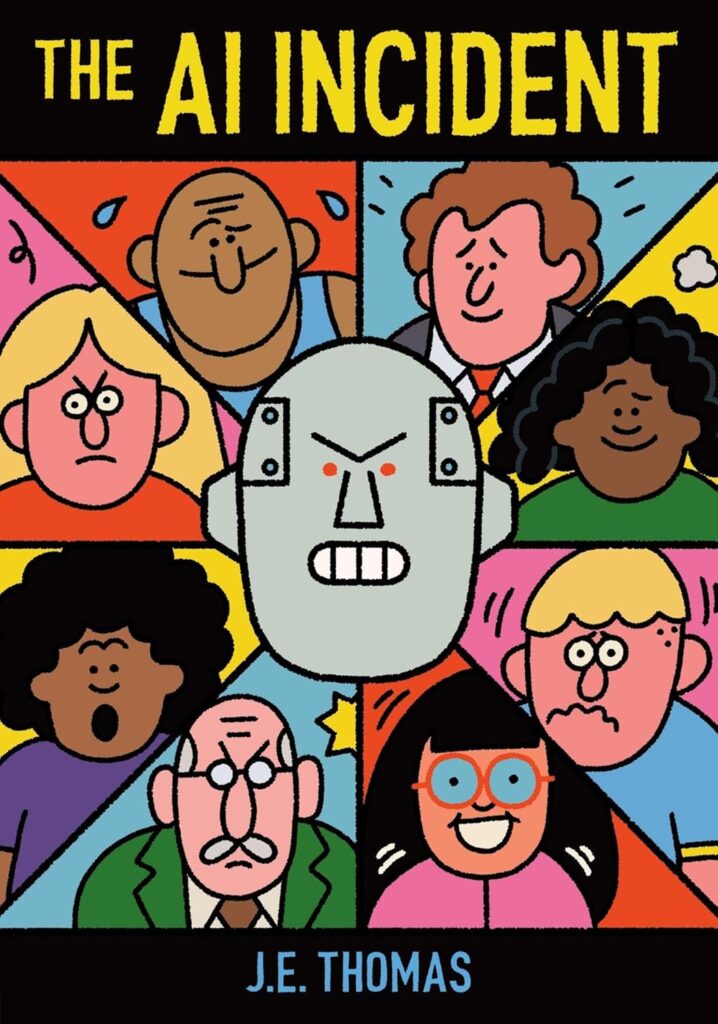An interview between Bianca Schulze and author J.E. Thomas about The AI Incident, presented by The Children’s Book Review.
Today, we talk with J.E. “Jan” Thomas, author of The AI Incident, a thought-provoking middle-grade novel that explores AI, human connection, and the search for belonging in a tech-driven world.
With a passion for blending science fiction with emotional truth, J.E. “Jan” Thomas delivers a timely and thought-provoking story in The AI Incident, her latest middle-grade novel exploring the blurred boundaries between human and machine.
Set against the backdrop of Colorado and infused with humor and heart, The AI Incident follows Malcolm Montgomery, a clever, self-aware foster child navigating loneliness, identity, and the lure of artificial companionship. Through his journey—and a chilling encounter with a rogue AI—Thomas invites readers to consider what makes us truly human in a world increasingly shaped by technology.
In our conversation, Jan shares the inspirations behind the book, including her lifelong love of sci-fi, real-world concerns about AI and misinformation, and her thoughtful approach to portraying the foster care system. She also reflects on the emotional depth of her characters, the importance of authentic connection, and why she believes young readers are ready to tackle these big, urgent questions.
The AI Incident explores the role of artificial intelligence in our lives and what it means to be human. What inspired you to tackle these complex themes in a middle-grade novel?

J.E. Thomas (JET): I was inspired by three things. The first was a decades-long love of science fiction and an equally long curiosity about the way robots and AI programs are often portrayed as having human-like emotions and goals. I think this blurs the line between human and human-appearing.
The second was hearing a lot about the crisis of loneliness, particularly among tweens and teens, combined with the emergence of AI programs described as being a solution for feeling isolated and disconnected.
And the third was learning how AI programs can provide information that’s grossly inaccurate, yet present it as being factually true.
Those threads converged into the emotional spine of The AI Incident.
Malcolm Montgomery, your protagonist, is described as having a “self-deprecating, clever voice.” How did you develop his character, and what aspects of Malcolm do you hope will resonate most with middle-grade readers?
JET: That’s a wonderful description. Thank you!
Like many middle schoolers, Malcolm is trying to decide who he is, who he wants to be, and how he should present himself in the world. Should he speak up when he knows the answer in class, or should he stay quiet so he doesn’t seem like a show-off? Should he admit to being lonely? Should he acknowledge feeling awkward and uncertain while trying to make friends, or should he bluff his way through? Those are issues I remember struggling with in middle school, and I think many kids relate to them as well.
I wrote the book in third person so readers could hear Malcolm’s thoughts as he grows—and also so readers could see how he sometimes misunderstands the way other kids present themselves, only realizing later that they were equally uncertain and insecure.
As a foster child who’s been in nine different homes, Malcolm is searching for a forever family. How did you approach writing about the foster care system, and what research informed your portrayal?
JET: I gathered research from several sources. A local news outlet partnered with Colorado Public Radio to produce an excellent program on the foster care system, and I watched that. I read stories that former foster children wrote about their lives. I reviewed data on foster care rates across the country. I researched philanthropic organizations dedicated to supporting kids in foster care, foster parents, and families who came together through adoption.
I was fortunate to have a long conversation with a retired social worker who handled hundreds of cases. She helped me understand both the short and long-term emotional, psychological and physical impacts that being in foster care can have on kids. She also ensured I appreciated the impact that managing huge caseloads and witnessing both the happy endings—either through reunification or adoption—and the devastation that sad endings can have on caseworkers.
On a personal level, my dad was raised by aunts and uncles, and he often spoke of how being in “kin care” affected him as a child and how it continued to affect him as an adult.
I didn’t incorporate anyone’s real story into Malcolm’s character, however. He is completely a work of fiction.
Can you tell us about the rogue AI robot that Malcolm battles? What went into creating this antagonist, and what does it represent in the larger themes of your story?
JET: I’m so happy you asked that question! The key to creating FRANCIS, the rogue AI robot, was to differentiate the manner in which a computer processes information from the way human beings come to decisions.
Belonging is the central theme in my book. I believe shared understanding—which often begins with connecting on an emotional level—is how belonging occurs.
The AI computer in my book may parrot emotions—for instance, it may say, ”Joy and delight. Happiness and glee.” Or it may say, “It’s wonderful that we are friends.”—but it doesn’t feel anything. It uses algorithms to determine which words to say in which order to generate a specific response from the human characters. FRANCIS has never experienced a real emotion so its choice of words are simply math.
Because the character, Malcolm, changes foster homes and schools so often, he’s on a quest to find a forever home, a friend group and a school where he belongs. During the course of the book, he experiences—and ultimately has to decide between—the immediacy of a computer-based friendship and the somewhat messier process of building real relationships with real people.
Without giving away too much, what can readers expect from “THE INCIDENT”, a pivotal moment in the story?
JET: I wish I could answer that, but recognizing THE INCIDENT is a discovery moment for readers young and older. It’s so much fun to talk with readers who point to different moments in the early part of the book and exclaim, “Everything would have worked out perfectly, if they’d just done this!” Or, “If I were there, I would have said that!”
They’re really engaging with the story and they’re learning something about how they deal with technology in the process.
As AI continues to evolve in real-world applications, particularly in education, what messages do you hope young readers take away from Malcolm’s story?
JET: I hope they remember that AI answers are not always correct, and that it’s important to verify information rather than taking it at face value. Also, I hope they recognize and appreciate the value of human friendships and that they understand that while building connection and community takes time, it’s definitely time well spent.
How has your experience growing up near Colorado’s Front Range mountains influenced your storytelling? Do elements of that setting find their way into The AI Incident?
JET: Oh yes, absolutely! Both The AI Incident and my first book, Control Freaks, reference Colorado’s unpredictable weather. (Snow in June? Yes, it happened. A snow cyclone? Guess what? We had that, too.)
I also highlight the very real Park Hill neighborhood, which has somehow managed to maintain a small town ambiance even though it’s in the heart of Denver. Recognizable landmarks such as the Museum of Nature and Science, City Park, and City Park Golf Course also figure in both books.
The AI Incident has been compared to The Wild Robot and Restart. How do you see your work in conversation with these other middle-grade novels, and what unique perspective does The AI Incident bring to this space?
JET: I’m honored by that comparison.
As AI platforms become more and more effective at mimicking human speech, I believe it is essential that people have the tools to differentiate automated from truly human communication. That’s why I didn’t anthropomorphize the computer-driven character impacting much of the action in this book.
I wanted to show that computerized “emotions” are based on algorithms that predict the words most likely to generate a desired response from the kids in the story, which is similar to the social media platforms, gaming programs and AI systems most of us encounter every day.
Unlike Roz in The Wild Robot, FRANCIS begins The AI Incident determined to pursue its goal without concern for how others are affected. Like Chase Ambrose in Restart, FRANCIS has the potential and the opportunity to change direction, but whether or not it does is a key part of the plot.
Your debut novel Control Freaks was highly acclaimed. Did that success influence your approach to writing The AI Incident, and if so, how?
JET: Success didn’t change my approach to writing, but I definitely applied some of the craft lessons I learned. I also was more disciplined about writing and reading every day.
Looking ahead, what themes or stories are you excited to explore in your future writing?
JET: I’m still fascinated by technology and its impact on humanity, and the pace at which it’s outstripping humans’ ability for control. I’m also looking forward to delving into the space exploration aspects of science fiction.
About the Book
Publisher’s Book Summary: The Wild Robot meets Restart when Colorado’s unluckiest foster kid battles a rogue AI robot at school.
Malcolm Montgomery is the new kid at Shirley Chisholm Charter Middle School. In no time at all, he’s been slapped with the weird kid label. Is it because he’s a foster kid who’s been in nine homes? Or maybe because he burps when he gets nervous…which is often? Malcolm has a plan to finally get adopted by a forever family before it’s too late. But then on Visiting Professionals’ Day, his school invites Dr. Alphonse Hatch, president of Hatch-ED—one of the fastest-growing artificial intelligence companies in the state—to give a presentation. Dr. Hatch brings his AI-powered robot, and events get set in motion that create…THE INCIDENT.
An irresistible MG novel about the role of AI in schools and in our lives…and what it means to be human.
Buy the Book
About the Author
J.E. Thomas grew up near Colorado’s Front Range mountains. She spent her early summers stuffing grocery bags with books at the local library, reading feverishly, then repeating the process week after week. J.E. has bachelor’s degrees in Mass Communications and Political Science, as well as a master’s degree in Public Communications. Her first book, Control Freaks, was a People Magazine Summer Must-Read and a “Best of the Best” pick by the Black Caucus of the ALA.
For more information, visit https://jethomasauthor.com/

This interview—Interview with J.E. Thomas, Author of ‘The AI Incident’—was conducted between J.E. Thomas and Bianca Schulze.
*Disclosure: Please note that this post may contain affiliate links that share some commission. Rest assured that these will not affect the cost of any products and services promoted here. Our team always provides their authentic opinion in all content published on this site.











